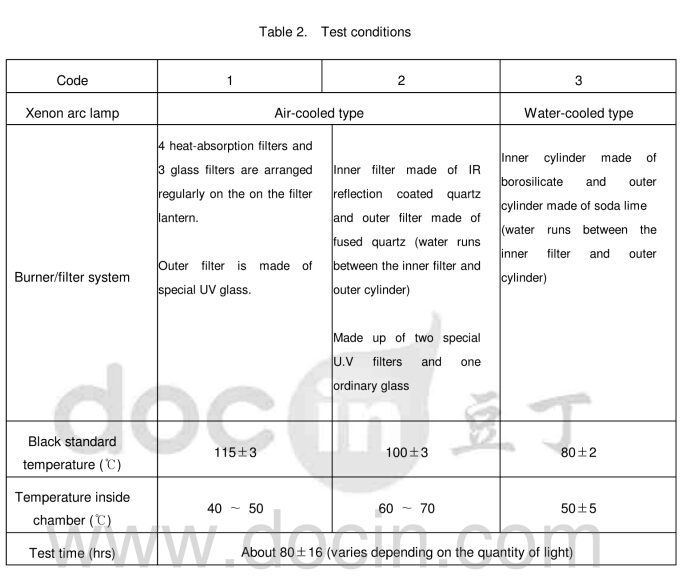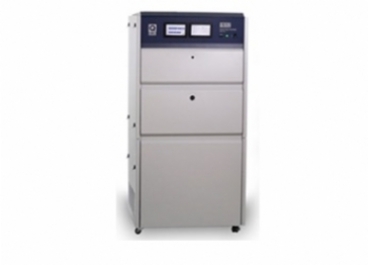咨询热线
18566398802EDS-T-7415测试标准
-> EDS-T-7415标准介绍
-> 符合EDS-T-7415的仪器
EDS-T-7415标准介绍
1.PURPOSE
This standard aims at specifying the method of evaluating colorfastness to artificial light of dyes, prints, paints and trim materials (textiles, genuine leather, artificial leather, plastics, cardboard, wood etc.) by exposing them to the artificial light similar to the natural light under a specific temperature.
2.SOCPE
Measurement of the color fastness to artificial light of various materials
3.DEFINITION
3.1. Color fastness to artificial light : It is a measure of the resistance of the colorants (dyes, pigments etc.) of materials to the effects of light and heat,
4.TEST PIECES AND NUMBERS OF TEST PIECES
4.1. Take test pieces of 70 X 220mm from the finished products or from the raw material so that the color and shape of the finished product is maintained. For textile, take the sample along warp thread and mount it on the test holder.
4.2. Test pieces for multiple exposure test shall be tested being backed by another material like polyester fleece.
The back of the test piece holder shall always be sealed. Unless specified otherwise, the thickness of such backing shall not be smaller than 5mm.
4.3. Threads or yarns shall be tightly wound around the cardboard and have the same dimensions as the test piece holder when tested.
4.4. For thick or backed-up test pieces, the difference between the distance from the light source to the surface of the test piece and that from the light source to the blue standard cloth for color fastness test or black panel thermometer surface shall not exceed 5mm.
4.5. For initial sample approval and for routine quality control, at least one test piece shall be tested. When specific requirements are not met in the test for arbitration purposes, the test shall be repeated with at least one test piece.
5.CONDITIONING
Tests shall be performed in the as received condition without any special pre-conditioning.
6.TEST EQUIPMENT
6.1. Light source, filter system and test apparatus
Test equipment permitting mounting of one or more xenon arc lamps as the light source. The light radiated from the lamp is filtered by the optical filter system, such as the absorption filter or absorption-reflection filter. Regardless of the type of the filter system, the radiant energy to be applied to test pieces shall conform to the requirements in Table l.

* The discrepancies between the irradiation intensity applied to the test piece and that to the blue standard cloth for color fastness test shall not exceed 10%. Table 2 shows the optical filter system to be used.
6.1.1. Absorption filter system
(1) Air-cooled xenon arc lamp test equipment (Ex: Xenotest 450 / Xenotest alpha)
The xenon arc lamp and filter system are cooled by air flow. As ozone is generated during the test, it shall be ensured that ventilation of air is carried out outside the laboratory. Unless otherwise specified, the burner for the lamp shall be replaced after 1500 0perating hours and filters shall be replaced after operation for the period specified by the manufacturer. The black panel thermometer shall be installed in the same position as the test piece and black standard temperature shall be adjusted according to Table 2.
(2) Water-cooled xenon arc lamps test equipment (Ex. Atlas Weather-O-meter Ci35 0r Ci65).
It is equipped with the water-cooled xenon arc lamp of adjustable wattage. Drop of irradiation intensity acting on the test piece surface resulting from aging of the lamp and filter system can be compensated for by increasing wattage of the xenon arc lamp. The lamp burner must be replaced when the desired irradiation intensity is no longer attainable. The test equipment without wattage control function shall be replaced after 1500 0perating hours. The black panel thermometer shall be installed in the same position as the test piece and black standard temperature shall be adjusted according to Table 2.
6.1.2. Absorption-Reflection filter system (Ex: Xenotest 1200)
(1) The system is cooled by air flow and ozone is not generated. The burner shall be replace after 1500 operating hours. As irradiation intensity drops after 500 hrs from burner replacement, wattage shall be adjusted
accordingly. The filter system partly made of the glass shall be replaced after operation for the period specified by the manufacturer. The black panel thermometer shall be installed in the same position as the test piece and black standard temperature shall be adjusted according to Table 2.
6.1.3. Black panel thermometer
The black panel thermometer, which indicates the surface temperature of the test piece in the test equipment, consists of a plain metal plate with a high heat transfer rate (70mm x 40mm, 0.5 t) and a thermometer attached to its back. The metal plate is attached to a plastic panel for thermal isolation from the source of radiation. The surface of the metal plate, which is coated in black, absorbs over 95% of infrared rays.
6.1.4. Gray scale
Used for evaluating discoloration of the test piece after color fastness test, It is a standard gray scale made of up of 5 grades.
6.1.5. Blue standard cloth for color fastness test (standard fabric approved by standards such as JIS L 0841) A series of blue wool fabric specially dyed to represent different color fastness, it is classified from grade l t0 8 depending on the color fastness. (Grade l standard cloth has the lowest color fastness and grade 8 standard
cloth has the highest color tastness). It permits comparison of color fastness regardless of the type, working method, color shade or color intensity of the part or material
6.1.6. Standard cloth for humidity adjustment Cotton fabric dyed with red azoic dye
6.1.7. Stamping device, scissors and cutter for test piece preparation
6.1.8. The test for arbitration and overlap exposure test shall be conducted under the same conditions using the same equipment (Xenotest 450 / Xenotest alpha in clause 6.1.1. (1》.
6.2. Test conditions
The test pieces and blue standard texture shall be exposed to the same light source inside the test equipment and temperature and humidity shall conform to Table 2.

7.PROCEDURE
7.1. Arrange the test piece according to clause 4 and install it onto the test equipment using the holder and then expose the blue standard texture to the light source according to test conditions in Table 2.
7.1.1. Method A (Code A)
This method is used to determine color fastness of the test piece for which no information on color change is available. A piece of blue standard cloth is needed for each test piece.
(1) Shield some l/3 0f the test piece and blue standard cloth with covers longitudinally and expose them to the light source according to Table 2 and then regularly examine the test piece to confirm discoloration.
(2) Remove the cover regularly and examine the test piece until the color difference between the exposed and unexposed portions of the grade 4 blue standard cloth corresponds to grade 4 0f the gray scale.
(3) Move the cover so that some l/2 0f the test piece is shielded longitudinally and expose it again to the light source. Stop the test until the color difference between the exposed and unexposed portions of the
grade 6 standard blue cloth becomes noticeable (corresponding to Grade 3 0n the gray scale).
(4) Compare the color difference of grade 7 blue standard cloth with the gray scale to determine the color fastness of the test piece (roughly between 7,7 ~8,8). If the color difference of grade 7 blue standard cloth corresponds to grade 4~5 0n the gray scale, the color fastness of the test piece is grade 7~8. If there is no color difference between the test piece and blue standard cloth, the color fastness of the test piece is grade 8.
7.1.2. Method B (Code B)
This method is used to see if the test piece meets the requirements in drawings or material specifications when such are specified.
(1) Shield some l/2 0f the test piece and blue standard cloth with covers longitudinally and expose them to the light source according to Table 2 and then regularly examine the blue standard cloth to adjust intensity of exposure.
(2) Stop the test when the color difference between the exposed and unexposed portions of the blue standard cloth of the specified grade is the same as the grade 4 0n the gray scale. Compare the color difference between the exposed and unexposed portions of the test piece with grade 4 0n the gray scale for evaluation.
7.1.3. Method C (Code C)
This method is used to evaluate surface change and physical properties/performance change as well as color change, after overlap exposure test. The number of exposure cycle shall be specified separately.
(1) Expose the test piece and blue standard cloth to the light source according to Table 2.
(2) End the exposure cycle when the color difference between the exposed and unexposed portions of the grade 6 standard blue cloth corresponds to Grade 3 0n the gray scale. Repeat for the specified exposure cycles. (Use a new blue standard cloth for each cycle.)
(3) Duration ot exposure cycle may vary depending on the irradiation energy applied o test piece.
7.1.4. Method D (code D)
This method is used for testing the material which is deformed under conditions of method B. Test equipment is under the same conditions as method B except that the test piece and blue standard cloth are inserted to the holder and the holder with the test piece on is turned 1800 around the longitudinal axis of the holder for each turn of the holder supporter.
7.1.5. If the test method, exposure conditions, etc. are not specified on the drawings or material specifications, perform -B3- test.
8.EVALUATION
8.1. Test according to method A, B and D
The color fastness of a test piece is the specific grade of a blue standard cloth whose color difference betweenthe exposed and unexposed portions is the same as grade 4 0r 3 0n the gray scale. Evaluate the test piece
until the color difference between the exposed and unexposed portions of the blue standard cloth of grade 7 corresponds to grade 4 and 3 0n the gray scale. When the color difference of the test piece comes in between two specific grades of the blue standard cloth, express it by the two grades with a dash inserted (Ex. grade 3 ~4). If the color difference is grade 3 0r above on the gray scale, perform the test again.
8.2. Test according to method C,
After completing the specified exposure cycle according to the characteristic values on drawings and material specifications, evaluate the test piece as follows:
8.2.1. Surface (Ex : gloss, crack and blister)
8.2.2. Physical properties and performance (Ex : tensile strength, abrasion, hardness)
8.2.3. Color change : visual check according to a gray scale
9.EXPRESSION OF RESULTS
The color fastness to artificial light shall be expressed by the grade according to the evaluation method in clause 8 (characteristic values included for tests according to method C), Record the apparatus used for the test in the test certificate or report.
10.CODING
The color fastness to artificial light is expressed as follows:

Designation Test method Detailed test method (clause 7) exposure (table 2) Requirements
Deviations from the requirements of this test method (e.g. black panel temperature etc.) shall have been agreed upon. Such deviations shall be specified in material specifications, drawing etc. and indicated in test certiticates, reports etc.
EDS-T-7415 ('91.7) : Method for determining color fastness to xenon arc light, etc
